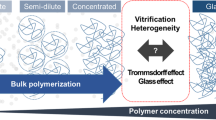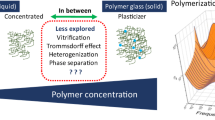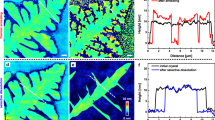Abstract
IT has been known for about a year that a large fraction of what appear to be planar reflective cracks in transparent polymers such as polystyrene, polymethyl methacrylate, and polycarbonate are not true cracks at all but rather are thin, abruptly bounded regions of material having different optical properties from the bulk polymer1. This material connects to the surrounding bulk polymer so that the pseudo-crack (henceforth termed a craze) will bear a tensile load in contrast to the true crack. Furthermore, such things as growth-rates under stress and ability to ‘heal’ under heat are quite different for the craze and the crack. Nevertheless, crazing produces stress heterogeneities, and for this reason at least is a precursor of cracking and fracture.
This is a preview of subscription content, access via your institution
Access options
Subscribe to this journal
Receive 51 print issues and online access
$199.00 per year
only $3.90 per issue
Buy this article
- Purchase on SpringerLink
- Instant access to full article PDF
Prices may be subject to local taxes which are calculated during checkout
Similar content being viewed by others
References
Niegisch, W. D., Fourth Meeting, Polymer and Fiber Microscopy Soc., Norwalk, Connecticut (May, 1961).
Smith, J. W., Electric Dipole Moments (Butterworth Scientific Publications, London, 1955).
Lazurkin, Yu. S., and Fogelson, R. L., Zhur Tekh. Fiz., 21, 267 (1951). Robertson, R. E., J. App. Polymer Sci. (in the press).
Author information
Authors and Affiliations
Rights and permissions
About this article
Cite this article
KAMBOUR, R. Optical Properties and Structure of Crazes in Transparent Glassy Polymers. Nature 195, 1299–1300 (1962). https://doi.org/10.1038/1951299a0
Issue date:
DOI: https://doi.org/10.1038/1951299a0
This article is cited by
-
Dilatational bands in rubber-toughened polymers
Journal of Materials Science (1993)
-
Correlation between craze formation and mechanical behaviour of amorphous polymers
Journal of Materials Science (1990)
-
Crazes in amorphous polymers I. Variety of the structure of crazes and classification of different types of crazes
Colloid & Polymer Science (1989)



